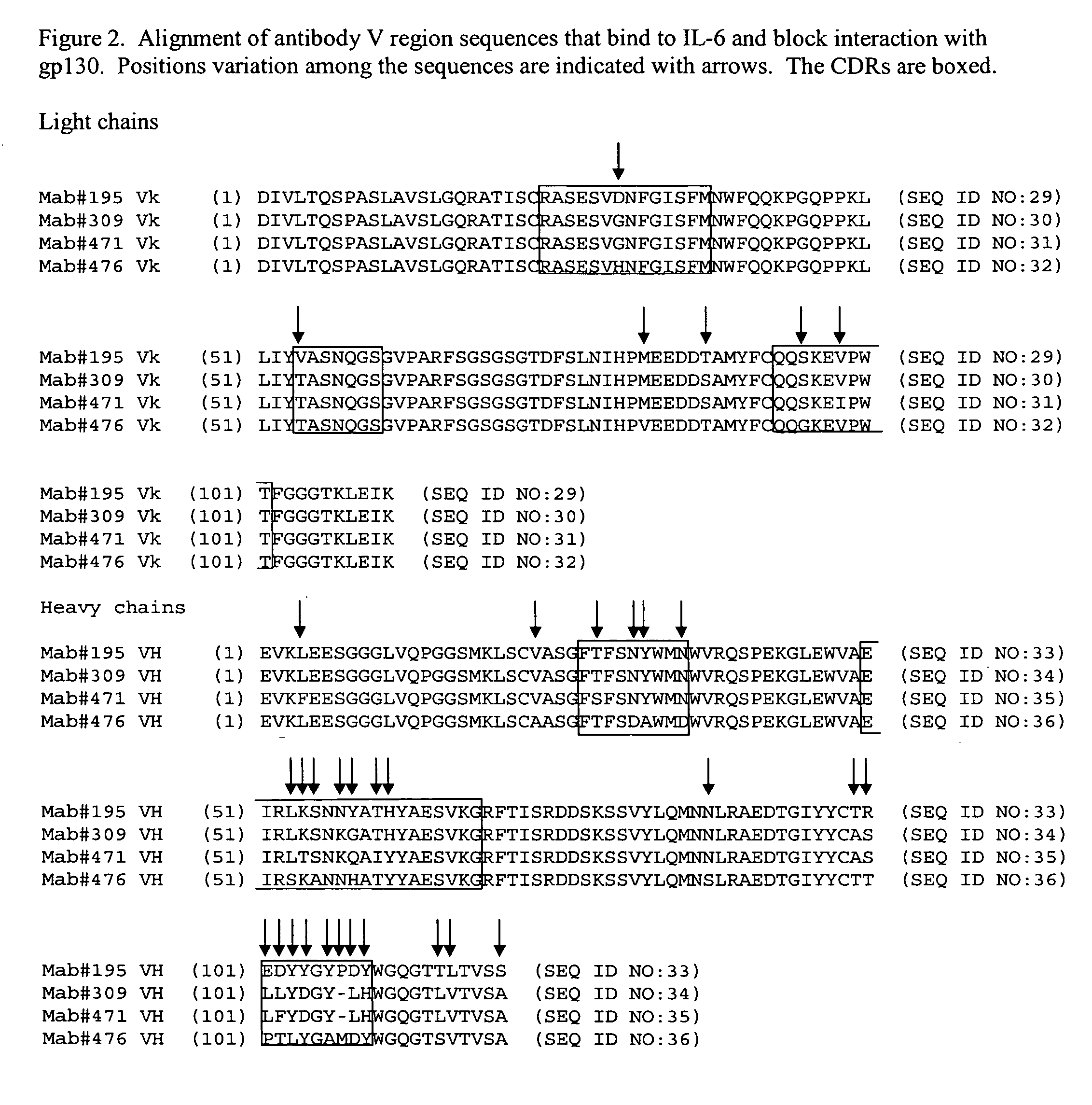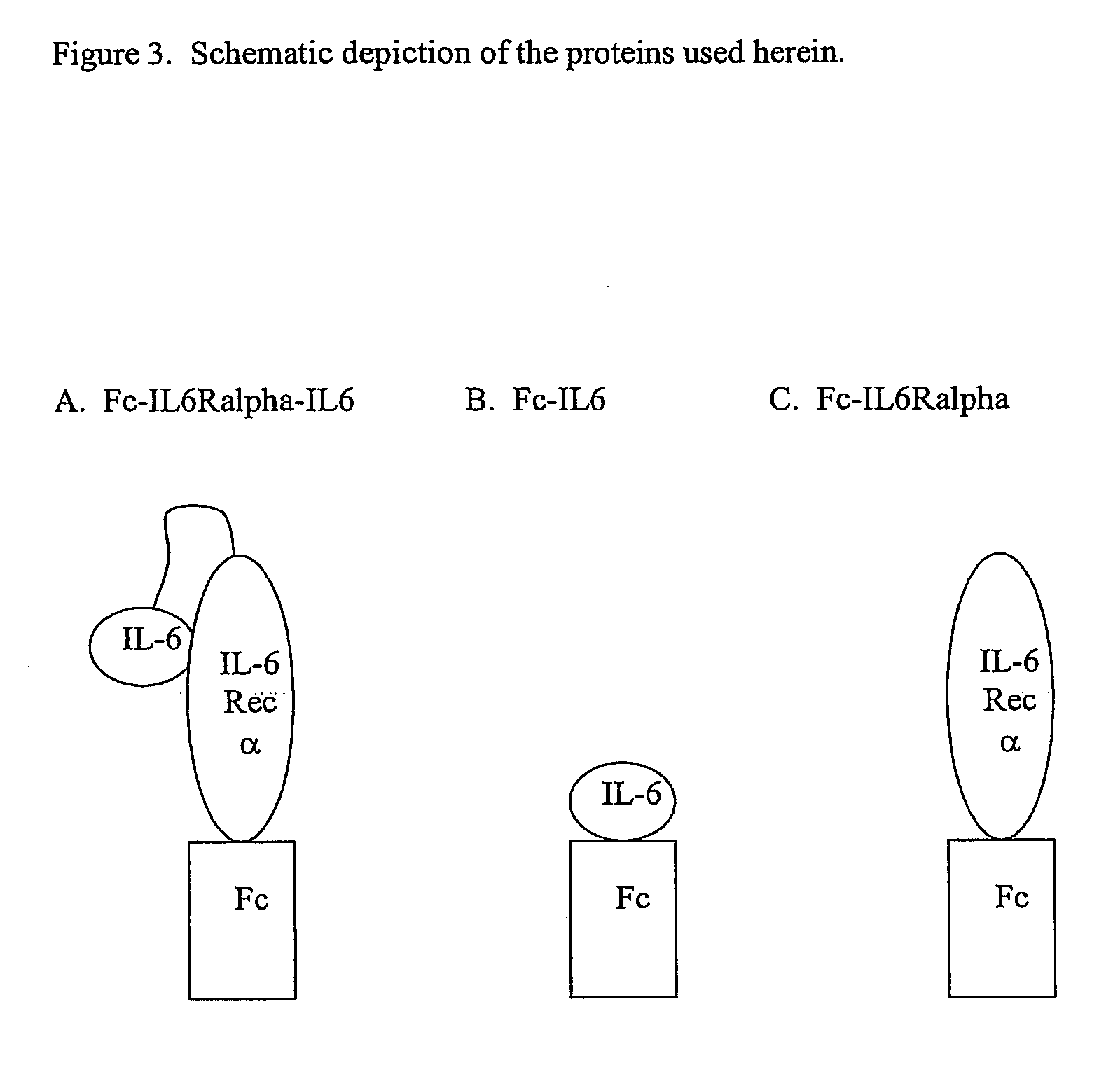Interleukin-6 antagonists
a technology of interleukin-6 and antagonists, which is applied in the field of anti-interleukin-6 antagonists, can solve the problems of wasting syndrome, ineffective treatment of patients with antibodies or other inhibitors, and pain,
- Summary
- Abstract
- Description
- Claims
- Application Information
AI Technical Summary
Benefits of technology
Problems solved by technology
Method used
Image
Examples
example 1
Expression of an IL-6 / IL-6Ralpha Complex for Use as an Antigen
[0064] To generate antibodies that bind to a surface of IL-6 that interferes with its binding to gp130 and is accessible in an IL-6 / IL-6Ralpha complex, a fusion protein comprising an Fc domain, the extracellular domains of IL-6Ralpha, and IL-6 was expressed from a plasmid termed pdCs-Fc-IL6Ralpha-IL6. The fusion protein is referred to herein as Fc-IL6Ralpha-IL6. The Fc domain was derived from mouse IgGγ2a, and the IL-6Ralpha and IL-6 were based on the human sequences. The sequence of this protein and the DNA encoding this protein are shown below.
Protein sequence of Fc-IL6Ralpha-IL6(SEQ ID NO:37):EPRGPTIKPCPPCKCPAPNLLGGPSVFIFPPKIKDVLMISLSPIVTCVVVDVSEDDPDVQISWFVNNVEVHTAQTQTHREDYNSTLRVVSALPIQHQDWMSGKEFKCKVNNKDLPAPIERTISKPKGSVRAPQVYVLPPPEEEMTKKQVTLTCMVTDFMPEDIYVEWTNNGKTELNYKNTEPVLDSDGSYFMYSKLRVEKKNWVERNSYSCSVVHEGLHNHHTFKSFSRTPGSGDDDDDKLPPEEPQLSCFRKSPLSNVVCEWGPRSTPSLTTKAVLLVRKFQNSPAEDFQEPCQYSQESQKFSCQLAVPEGDSSFYIVSMCVASSVGS...
example 2
Immunization with an IL-6 / IL-6Ralpha Complex
[0070] Twenty mice (Balb / C) were immunized with the Fc-IL6Ralpha-IL6 protein produced as described in Example 1, and monoclonal antibodies to this protein were produced according to a modification of the method of Kohler and Milstein (1975) (Nature, 256:495-7). Specifically, 1 microgram of Fc-IL6Ralpha-IL6 was injected subcutaneously with 100 microliters of complete Freund's adjuvant. Injections were repeated 14 days later, using 1 microgram of protein injected intraperitoneally with 100 microliters of incomplete Freund's adjuvant. 24 days after the first injection, mice were boosted with 1 microgram of Fc-IL6Ralpha-IL6 protein in 100 microliters of PBS intravenously. Three days later mice were sacrificed and spleens excised, and spleen cells cultured according to standard procedures. 435 million spleen cells from two mice with strong polyclonal anti-IL6Ralpha / IL6 responses were fused with 175 million NS / 0 cells at a ratio of 2.4 spleen c...
example 3
Screening for Antibodies that Block the Interaction Between the IL-6 / IL-6Ralpha Complex and gp130
[0071] Binding
[0072] Positive clones from Example 2 were further tested as follows. The isotype of the antibody was determined, and IgM-based clones were not characterized further. IgG-based monoclonal antibodies were tested for their ability to bind to either IL-6 or IL-6Ralpha using immobilized Fc-IL6 and Fc-IL6Ralpha according to standard procedures. Some clones bound to IL-6, some bound to IL-6Ralpha, and some bound to neither proteins, suggesting that these monoclonals might recognize some portion of the linker or might recognize composite epitopes consisting both IL-6 and IL-6Ralpha moieties.
[0073] Exemplary results of the binding characteristics of typical antibodies of the invention are shown in FIG. 4 (binding to Fc-IL6Ralpha-IL6), FIG. 5 (binding to IL-6), FIG. 6 (binding to non-covalently complexed IL-6 and IL-6Ralpha), and FIG. 7 (IL-6Ralpha alone). The results indicate th...
PUM
| Property | Measurement | Unit |
|---|---|---|
| Fraction | aaaaa | aaaaa |
| Fraction | aaaaa | aaaaa |
| Volume | aaaaa | aaaaa |
Abstract
Description
Claims
Application Information
 Login to View More
Login to View More - R&D
- Intellectual Property
- Life Sciences
- Materials
- Tech Scout
- Unparalleled Data Quality
- Higher Quality Content
- 60% Fewer Hallucinations
Browse by: Latest US Patents, China's latest patents, Technical Efficacy Thesaurus, Application Domain, Technology Topic, Popular Technical Reports.
© 2025 PatSnap. All rights reserved.Legal|Privacy policy|Modern Slavery Act Transparency Statement|Sitemap|About US| Contact US: help@patsnap.com



